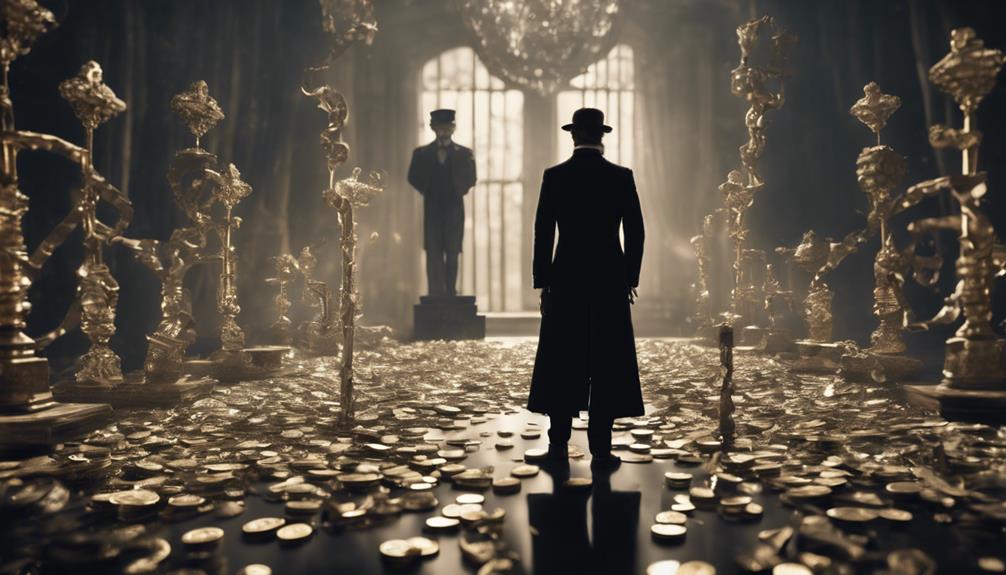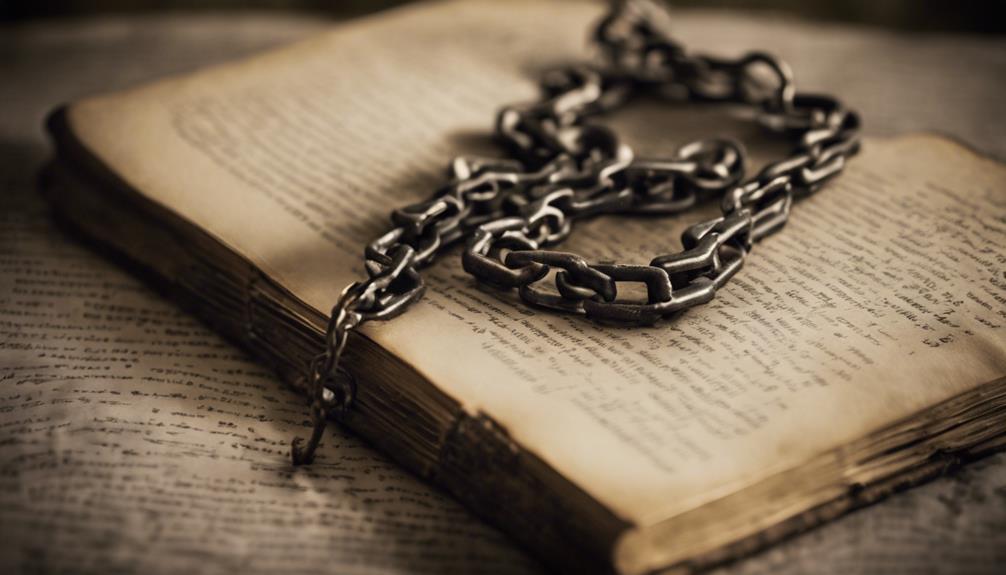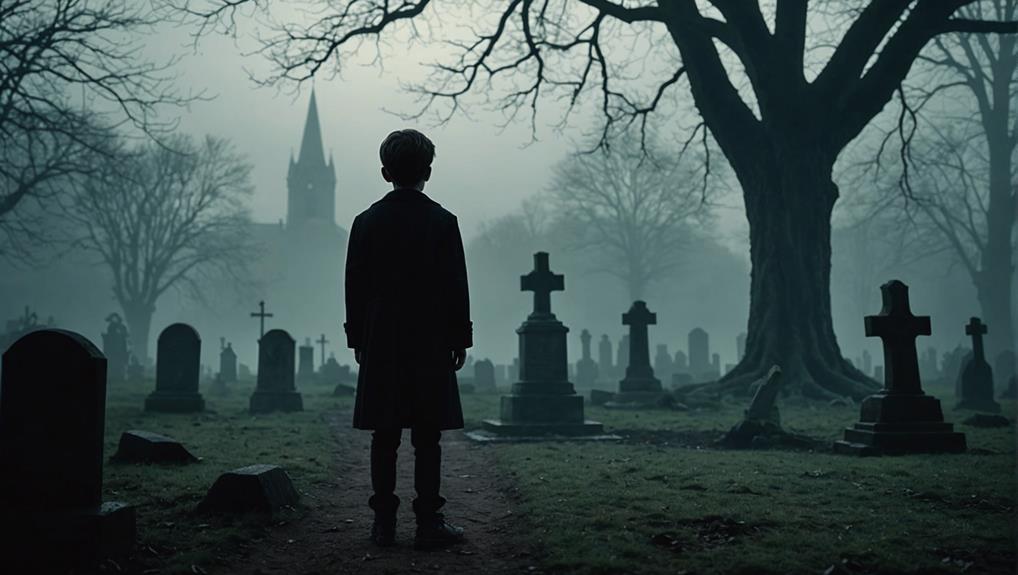Embark on Pip's transformative odyssey in 'Great Expectations', shaped by love, ambition, and societal complexities. Witness Pip's journey from humble beginnings to the tangled web of Miss Havisham's world and his pursuit of Estella. Discover how encounters with diverse characters like Magwitch and Joe challenge Pip's perceptions. Uncover themes of social class impact, self-discovery, and moral choices. Explore the atmospheric settings like Satis House and Joe's Forge that enrich the narrative. Explore deeper into the symbolism and character dynamics that add layers to this classic tale. Get ready for an immersive exploration of themes and characters in this timeless Dickensian masterpiece.
Plot Overview
Begin a journey through the intricate plot of 'Great Expectations' as it reveals the life of orphan Pip from childhood to adulthood.
One of the key relationships that shapes Pip's journey is his interaction with Miss Havisham, a wealthy but eccentric woman who plays a pivotal role in his life. Miss Havisham, who lives in a decaying mansion frozen in time, introduces Pip to her adopted daughter, Estella.
Estella, raised by Miss Havisham to break men's hearts, captivates Pip from their first meeting, sparking feelings of love and desire within him.
Throughout the plot, Pip's infatuation with Estella and his desire to become a gentleman lead him through a series of trials and tribulations. His encounters with Miss Havisham and Estella serve as catalysts for his personal growth and self-discovery, pushing him to confront his own values and aspirations.
As Pip navigates the complexities of love, ambition, and betrayal, his interactions with these characters shape the trajectory of his life in 'Great Expectations'.
Character Analysis
In 'Great Expectations', the characters of Pip, Miss Havisham, Estella, Magwitch, and Joe each contribute uniquely to the intricate tapestry of the novel's narrative.
- Pip: As the protagonist, Pip's journey from humble beginnings to unexpected fortune and the subsequent moral dilemmas he faces provide a lens through which readers witness personal growth and the complexities of class and ambition.
- Miss Havisham: Her jilted bride persona and manipulation of Pip and Estella create an atmosphere of decay and revenge, influencing the lives of those around her.
- Estella: Molded by Miss Havisham to be cold-hearted and unattainable, Estella's interactions with Pip reflect themes of love, rejection, and societal expectations.
- Magwitch: The convict turned secret benefactor challenges Pip's perceptions of class and morality, showcasing the unexpected ways in which relationships can shape one's identity.
Themes Explored

Delving into the intricate layers of 'Great Expectations,' themes of social class, self-discovery, loyalty, and moral dilemmas are skillfully intertwined to create a compelling narrative of personal growth and introspection.
The novel explores the impact of social class on characters like Pip and Estella, highlighting the disparities and challenges they face based on their backgrounds.
As Pip navigates his journey of self-discovery and coming of age, readers witness the evolution of his identity and values. Loyalty and compassion are valued over material wealth, emphasizing the true worth of individuals beyond societal expectations.
The characters in 'Great Expectations' grapple with their pasts and futures, reflecting on their identities and the search for authenticity.
Through the exploration of wealth versus values, the novel presents moral dilemmas that shape the personal growth and decisions of the characters, elevating the narrative to a profound reflection on human nature and societal norms.
Setting Details
You'll find that the setting details in 'Great Expectations' play a vital role in shaping the story. From the eerie Satis House to the foggy marshes of Kent, these locations create a rich backdrop that enhances the novel's themes and mood.
The stark contrast between rural and urban settings mirrors the social and personal transformations experienced by the characters.
Key Setting Locations
Exploring the key setting locations in 'Great Expectations' provides essential insights into the characters' experiences and the development of the plot.
- Satis House:
This decaying mansion, cloaked in darkness and frozen in time, becomes a haunting symbol of Miss Havisham's bitterness and Estella's upbringing, shaping Pip's aspirations and perceptions of love and wealth.
- London:
The vibrant city streets of London, juxtaposed with the legal domain of Mr. Jaggers, serve as the stage for Pip's societal climb and moral reckoning, highlighting the contrasts between appearances and reality.
- Marshes of Kent:
The misty and desolate marshes of Kent, where Pip encounters the convict Magwitch, set the tone for the novel's themes of crime, guilt, and redemption, marking the beginning of Pip's transformation.
- Joe Gargery's Forge:
Nestled in the village of Kent, the warm and welcoming forge of Joe Gargery stands as a reminder of Pip's humble roots and the values of loyalty and integrity that guide him amidst the allure of wealth and status.
Atmosphere and Mood
The eerie setting of 'Great Expectations' envelops readers in a haunting and melancholic atmosphere, heightening the emotional impact of the characters' experiences. Miss Havisham's Satis House, a decaying mansion frozen in time, serves as a central location that embodies this atmosphere. The mansion's dilapidated state, along with Miss Havisham's haunting presence and the remnants of her wedding feast suspended in time, create a sense of unease and sorrow.
The desolate marshes near Pip's home further contribute to the mood of isolation and despair. The foggy and bleak landscape mirrors Pip's internal struggles and sets a tone of foreboding.
As Pip navigates through the grimy streets of London, the bustling urban life reflects the harsh realities he encounters, adding to the overall atmospheric richness of the novel.
Through the varied settings, from the decaying Satis House to the desolate marshes and bustling city streets, 'Great Expectations' masterfully crafts an atmospheric backdrop that enhances the emotional depth of the story.
Narrative Structure

How does Dickens' use of a nonlinear narrative structure in 'Great Expectations' enhance your experience of Pip's journey?
- Imagine jumping back and forth in Pip's timeline, from his humble beginnings as a blacksmith's apprentice to his unexpected rise in social status.
- Visualize the unfolding of Pip's inner turmoil and conflicts through the fragmented storytelling, mirroring his own confusion and growth.
- Picture the moments of revelation and surprise as past events are revealed, shedding light on Pip's present circumstances and relationships.
- Envision yourself piecing together the puzzle of Pip's life alongside him, feeling the suspense build as the narrative structure keeps you eagerly turning the pages.
Dickens' strategic use of a nonlinear narrative structure not only adds layers of complexity to the plot but also immerses you in Pip's evolving journey of self-discovery and transformation. Through this unique storytelling technique, you're invited to unravel the intricacies of Pip's life, his choices, and the consequences that shape his destiny.
Symbolism Unveiled
Symbolism in 'Great Expectations' reveals hidden layers of meaning that enrich the story's themes and characters. Miss Havisham's decaying mansion, Satis House, serves as a poignant symbol of stagnation and halted time, mirroring her frozen heart and embittered soul.
Estella, the epitome of wealth and beauty, symbolizes an unattainable ideal that drives Pip's aspirations. The marshes, with their murky and mysterious nature, symbolize Pip's humble origins and the enigmatic depths of his past.
Throughout the narrative, the motif of fire and light emerges as a symbol of transformation and enlightenment in the characters' journeys. These symbols intertwine to provide a rich tapestry of meaning, shedding light on the characters' inner struggles, desires, and growth.
As you explore further into 'Great Expectations', pay attention to these symbols, for they serve as keys to uncovering the deeper layers of Dickens' masterful storytelling.
Impact on Literature

Dickens's 'Great Expectations' has left a lasting imprint on the landscape of English literature, shaping subsequent works with its intricate plot twists and character development. Through its influence, the novel has become a cornerstone of literary analysis and storytelling techniques.
Social Commentary: Dickens's exploration of class struggles, wealth, and societal expectations in 'Great Expectations' set a precedent for using literature as a platform for social critique.
Character Development: The vividly drawn characters in the novel, such as Pip, Miss Havisham, and Magwitch, have served as archetypes for complex and multifaceted characters in later literary works.
Serialized Format: The success of 'Great Expectations' in its serialized form paved the way for other authors to release their works in a similar manner, increasing accessibility and engagement with readers.
Literary Legacy: The enduring popularity of 'Great Expectations' has inspired countless writers to explore themes of ambition, identity, and redemption, cementing its place in the literary canon.
Notable Adaptations
Explore the various adaptations of 'Great Expectations' across film, television, stage, and radio, showcasing the novel's enduring popularity and adaptability to different storytelling mediums.
'Great Expectations' has been reimagined in various forms, with notable adaptations such as the 1946 film directed by David Lean and the 2012 version featuring Helena Bonham Carter as Miss Havisham. Television series, stage plays, and radio dramas have also brought the classic tale to life, highlighting its timeless appeal and ability to captivate audiences across generations.
Additionally, the 1998 modern-day film adaptation starring Ethan Hawke and Gwyneth Paltrow further demonstrates the enduring popularity of 'Great Expectations' and its ability to resonate with contemporary audiences. Through these adaptations, the complex characters and intricate plot crafted by Charles Dickens continue to be celebrated and reinterpreted, solidifying 'Great Expectations' as a beloved classic with a lasting legacy in the world of storytelling.
Conclusion
To sum up, 'Great Expectations' by Charles Dickens continues to captivate readers with its intricate plot and memorable characters.
It's worth noting that the novel has been adapted into over 20 different film and television versions, showcasing its enduring popularity and impact on popular culture.
From its exploration of social class to its timeless themes of love and redemption, 'Great Expectations' remains a classic that continues to resonate with audiences worldwide.



